The Portuguese Ironclad
In the early 16th century, Portugal, the most prosperous nation on earth thanks its innovations in navigation, exploration and conquest had an immense colonial Empire strectching from the coasts of Africa, to South America, the Indian Ocean, Indonesia and even China. However the great wheel of nationhood veered in favor of northern powers, notably France and Britain, and the Portuguese fleet gradully dwindled, following many successive budget cuts in the XVIII and XIX centuries. So much so that in 1870, despite a 800,000 square miles empire, the country proved unable to manage and exploit it, and the fleet was just two 28-guns steam frigates and a single 14 guns corvette as well as six wheeled steamers (26 guns each), the sailing ship Vasco da Gama (74), Dom Fernando (50), and three 14-guns corvettes.
Maintaining its empire and defend her insterests worldwide became problematic, so at least to defend the capital and Tagus, entry into the country, it was believed that a modern, armoured and armed with modern rifled guns was necessary. No local yard could handle this and so, the new government managed to negociate construction of a small but modern and tailored ironclad in Great Britain. Indeed, the ship would have a tonnage no more than 2,300 tonnes, but be well armed and well protected.
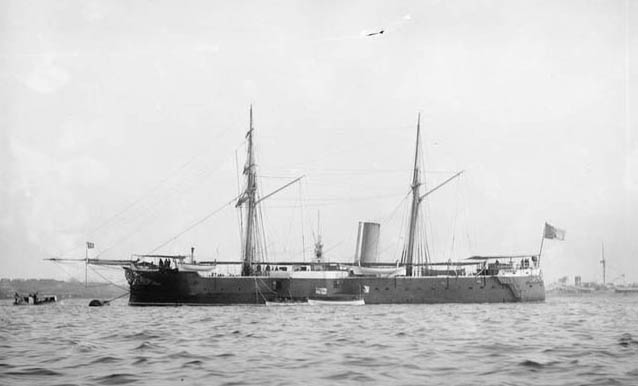
Vasco Da Gama 1895
The new Vasco de Gama thus became the only capital ship of the Portuguese Navy ever built. She was ordered from British shipyard Thames Iron Works, Blackwall, London to defend the capital Lisbon. She was a rather small, “coastal” ironclad compared to the 12,000 tonnes ships built at the time, but with a central battery and Barquentine rig. No longer relevant at the end of the century, she was extensively reconstructed in 1901-1903. So much so her new appearance was completely new, as well her size, equipments and armament. Now looking like a cruiser, she served during WWI as Portugal remained neutral, and was discarded in 1935.
Design
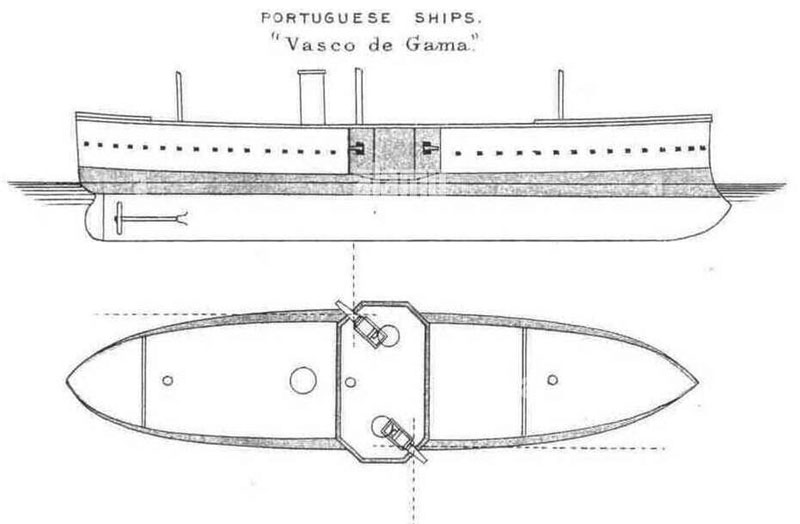
General design outlines – Brasseys 1880
Vasco da Gama measured 200 feets (61 m) between perpendiculars for 40 ft (12 m) in breadth. She had some tumblehome and so at main battery lefel she reacheds 46 ft 6 in (14.17 m) of width. Maximum draft was designed was 19 ft (5.8 m) for a total displacement, standard, of 2,384 metric tons (2,346 long tons; 2,628 short tons). She was rigged as a barquentines, with three masts, the mainmast having 3-stage squared rigging and the two others schooner sails.
Propulsion
Vasco da Gama had a marine steam engine, driving a single screw propeller and steam pcome from four (assumed to be four) boilers truncated into a single exhaust a funnel slightly aft. The senemble was rated at 3,000 indicated horsepower (2,200 kW). This was enough for a designed top speed of 10.3 knots (19.1 km/h; 11.9 mph). Later in the 1880s her riggng was simplified as a two-masted barquentine rig. In all between the artillery, steam engine and rigging she needed a crew of 232 officers and men.
Armament
Her original main battery comprised two 10.2 in (260 mm) guns in a central armored and octagonal box, amidships. Each gun was mounted on semi-circular tracks for 90° traberse, with two gun ports for each, while the box overhanged beyond the sides to allow fire in chase and retreat. A single 5.9 in (150 mm) deck gun was mounted on her stern, with large traverse, likely to fire incendiary bombs (Paixhans type). It seems in the 1880s she received four 9-pounder guns for close-range defense against torpedo boats.
Protection
Vasco Da Gama was protected with a complete iron armored belt, 4 inches (100 mm) thick on either end, 9 in (230 mm) amidships, protecting ammunition magazines and over the machinery spaces. The main battery box amidhships had the thickest armor plating, from 6 to 10 inches (150 to 250 mm).
Modifications and reconstructions
profile after reconstruction
Vasco Da Gama was already modified in the late 1880s (exact date unknown), with the rigging reduced and simplified, and four 9-pdr QF guns for anti-torpedo defense. But the major reconstruction, complete, intervened between 1901 and 1903 and was performed at the italian Yard Orlando, Leghorn after an international call to tender. She was drastically reconstructed, the most impressive feat being the hull cut in half and lengthened:
She received indeed an extra 32 ft 6 in (9.91 m) long section amidships while the central casemate was eliminated and the artillery completely modified in locations and types altogether. Her final dimensions were: 70.9 m between perpendiculars (232 ft), same beam, without overhang or tumblehome, but 6.27m (20.57 ft) in draught.
The fact she was lenghtened so cut in half, allowed engineers to also removed the antiquated engine, replaced by two modern VTE steam engines (triple expansion), and far more modern and powerful Yarrow powerful water-tube boilers, the ensemble being rated at 6,000 ihp (4,500 kW) for a top speed to 15.5 kn (28.7 km/h; 17.8 mph).
She also received a brand new set of superstructures, including a modern bridge, two pole mast for wireless telegraphy, while the armament was completely renewed as well. Her armour scheme was also modified: The old iron belt armor was removed, replaced by a stronger, modern steel armor belt. It is unclear if this was complemented by an armoured deck.
For armament, she gained two brand new 8 in (203 mm) L/40 guns, located in sponsons forward, port and starboard, about at the the level of the bridge. A new long-barreled 5.9-inch L/45 gun was installed aft, and six 3-pdr were also installed for close-range defense, apparently in addition to the earlier 9-pdr models. The crew rose to 260 officers and men displacement jumped to 2,972 metric tons (2,925 long tons; 3,276 short tons) in normal draught, 3200 tonnes fully loaded.
She stays the same for after WWI. In 1922: the armament was changed again, with a single 203mm/40, remaining and a single 76mm/40 AA gun installed from Vickers, plus a single 102mm/40 QF Mk IV dual purpose gun installed aft, in replacement of her 5.9-inch L/45. Her 9-pdr QF had been removed at this point but she probably still carried the 3-pdrs.
⚙ Specifications before after reconstruction* |
|
| Displacement | 2384, 2972/3200* tons st./fl. |
| Dimensions | 61/70.9* x 14.2/12.2* x 5.79/6.27* meters |
| Propulsion | 1shaft, 2VC/4 boilers 3000 shp, 2 shafts VTE/2 Yarrow Boilers 6000 shp* |
| Speed | 10.3 kts, 15.5 kts* |
| Range | 300 tons coal, 2500(9 knots), unchanged |
| Armament (1876) | 2x 263mm/18 RK L/20 C/74, 1x 149mm/22 RK L/22 C/75, 4x 67mm/40 Krupp |
| Armament (1903) | 2x 203mm/40 (8 in), 1x 152mm/45 (6 in), 6×1 47mm/40 (3 in) |
| Armament (1922) | 1x 203mm/40, 1x 76/40 (3 in) 1x 102mm/40 (4 in) QF Mk.V |
| Protection (1876) | Iron belt 102-229mm (4-9 in), battery 152-254mm (6-10 in) |
| Protection (1903) | Steel belt 100-250mm (4-10 in), deck 75mm (3 in), gun shields 200mm (8 in) |
| Crew | 232, 260* |
Src/Read More
Books
Brassey, Thomas (1905). The Naval Annual. Portsmouth, UK: J. Griffin & CO
Chisholm, Hugh (1912). The Encyclopædia Britannica XXXII ed. London: Encyclopædia Britannica
Gardiner, Robert; Gray, Randal (1979). Conway’s All the world’s fighting ships, 1860-1905. NIP
Gardiner, Robert; Gray, Randal (1985). Conway’s All the world’s fighting ships, 1906-1921. NIP
Intelligence, US Office of Naval (1898). Notes on Naval Progress. Washington, DC: Government Printing Office
Mason, Herbert B. (1908). Encyclopaedia of Ships and Shipping. London: The Shipping Encyclopaedia.
Palmer, W (1908). Hazell’s Annual. London: Hazell, Watson & Viney
Paloczi-Horvath, George (1996). From monitor to missile boat: coast defence ships and coastal defence since 1860. Conway Maritime Press
Links
On jstor.org warships international article
wiki EN
wiki Portugal
On arquivohistorico.marinha.pt
On navypedia.org
Model kits
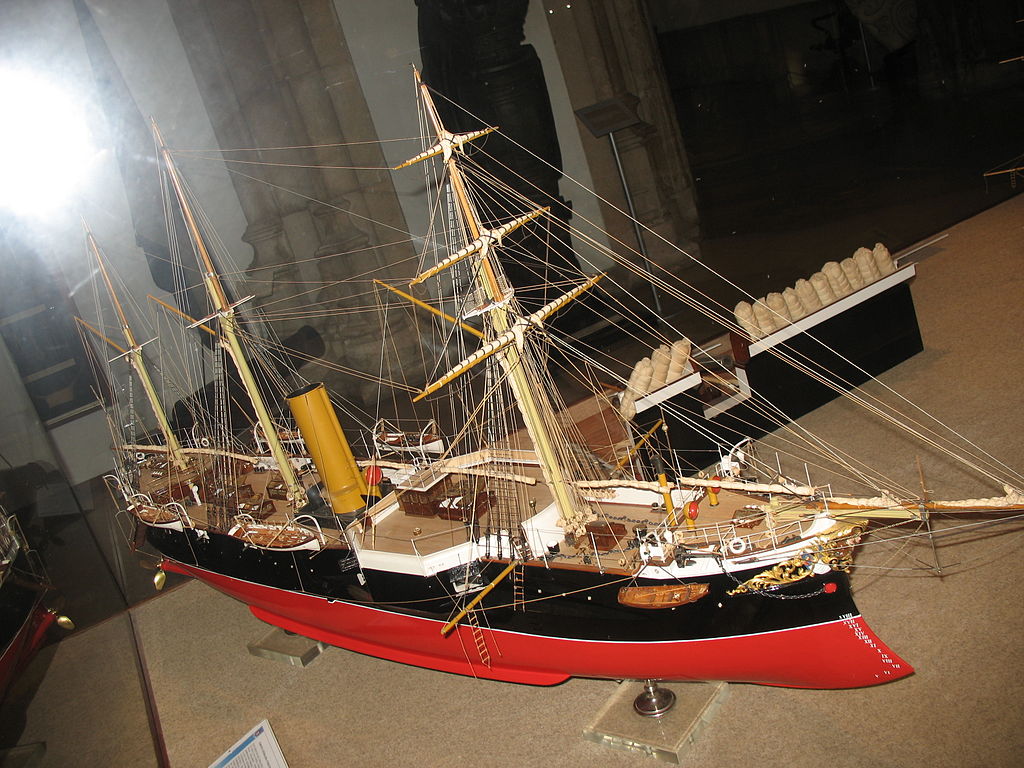
A Yard model of the Vasco da Gama as completed in Lisbon Museum. It clearly shows three masts and not two as frequently seen.
None found yet !
Active service and transformation
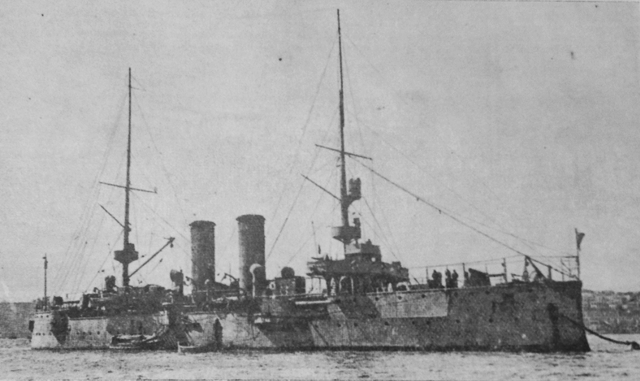
Vasco da Gama, laid out in 1875 at Thames Iron Works of London, launched in 1876 would have a long career, which stopped short of WW2. Completed in 1878 and classed by the Portuguese as an “armoured frigate” due to her size, Vasco da Gama became nevertheless the only “battleship” ever in the Portuguese navy. When after her sea trials and official acceptance she arrived on the mouth of the Tagus after her trip from Britain via the channel, bay of biscay and Basque coast, immense crowds invaded the shores to gret her out. Sge arrived in Lisbon surrounded by hundreds of shuips, all flags out.
At first, she operated as planned, as part of the coastal defense of Lisbon, the capital. She was also tasked to patrol the mouth of the Tagus. On June 26, 1897, she participated in the Spithead Fleet review in celebration of Queen Victoria’s Diamond Jubilee, under command at the time of Captain Barreto de Vascomellos. The rest of her career was unevenftul, between periods of maintenance and inactivity and patrols at sea.
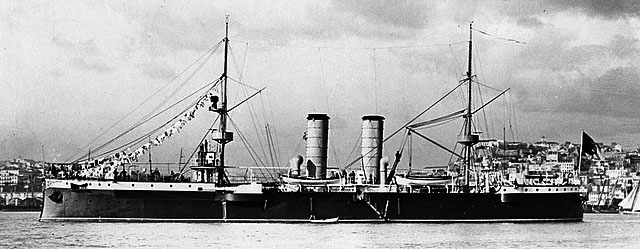
Vasco da Gama after refit, with her 1900s colors.
In 1901, the Portugsuses Navy staff was fully aware she needed a radical modernization, or facing the scrapyard. After funds were secured at the parliament, an international call to tende saw the Orlando shipyard drydock in Livorno, Italy, chosen for a major rebuild based on their proposed reconstruction design. It was indeed radical: She was cut in half, elongated, received new enginesat 6,000 ihp (4,500 kW), being able now to reach 15.5 knots (28.7 km/h; 17.8 mph), but still ran on coal. Her armour was modrnized and her whole battery modernized also. Her displacement rose as a result, but she was still small for even a cruiser at that time. The reconstruction works last two years, as she was completed in 1903. After sea trials and full acceptance she made a training cruise in the Western Mediterranean until reaching Gibraltar and transiting to the Atlantic.
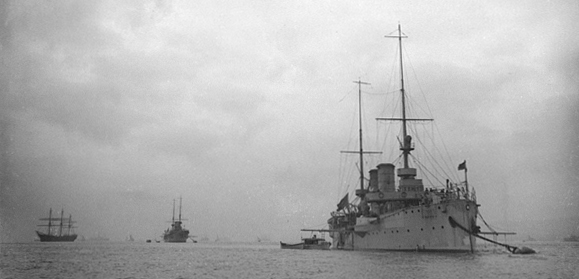
Vasco Da Gama and Adamastor during WWI
Nothing much happened during her later career, she had exactly the same role. On August 27, 1907, however she was wrecked by an accidental gas explosion, injuring several crew members. The political unrest of April 1913 saw part of her crew excluded for their disloyalty to the new Government, as they were planning a coup against the First Portuguese Republic. On May 14, 1915, they mutinied and killed the ship’s captain. Vasco Da Gama then proceeded to Lisbon and shelled the city, killing a hundred, harming the very city she was tasked to defend. Despite of all of this, Vasco da Gama remained the Portuguese Navy flagship until WWI broke out. A replacement or new modernization was rejected due to budgetary constraints, and although obsolete by 1918, she remained active until 1935 listed as a coast guard vessel, slightly modernized in 1922. Eventually she was sold for scrap in 1935.
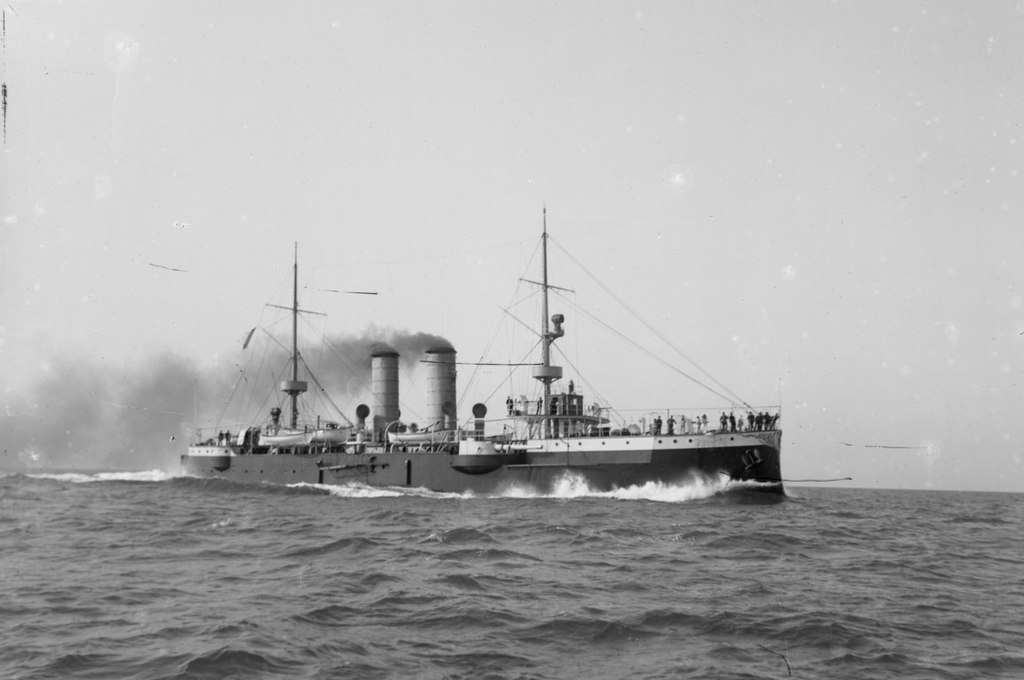
A nice, large image of Vasco Da Gama in post-reconstruction sea trials, 1903, off the coast of Italy.
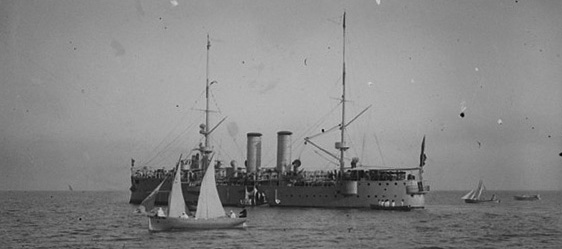
Vasco Da Gama in the interwar, date unknown, probably post-1922


 Latest Facebook Entry -
Latest Facebook Entry -  X(Tweeter) Naval Encyclopedia's deck archive
X(Tweeter) Naval Encyclopedia's deck archive Instagram (@navalencyc)
Instagram (@navalencyc)





 French Navy
French Navy Royal Navy
Royal Navy Russian Navy
Russian Navy Armada Espanola
Armada Espanola Austrian Navy
Austrian Navy K.u.K. Kriegsmarine
K.u.K. Kriegsmarine Dansk Marine
Dansk Marine Nautiko Hellenon
Nautiko Hellenon Koninklije Marine 1870
Koninklije Marine 1870 Marinha do Brasil
Marinha do Brasil Osmanlı Donanması
Osmanlı Donanması Marina Do Peru
Marina Do Peru Marinha do Portugal
Marinha do Portugal Regia Marina 1870
Regia Marina 1870 Nihhon Kaigun 1870
Nihhon Kaigun 1870 Preußische Marine 1870
Preußische Marine 1870 Russkiy Flot 1870
Russkiy Flot 1870 Svenska marinen
Svenska marinen Søværnet
Søværnet Union Navy
Union Navy Confederate Navy
Confederate Navy Armada de Argentina
Armada de Argentina Imperial Chinese Navy
Imperial Chinese Navy Marinha do Portugal
Marinha do Portugal Mexico
Mexico Kaiserliche Marine
Kaiserliche Marine 1898 US Navy
1898 US Navy Sovietskiy Flot
Sovietskiy Flot Royal Canadian Navy
Royal Canadian Navy Royal Australian Navy
Royal Australian Navy RNZN Fleet
RNZN Fleet Chinese Navy 1937
Chinese Navy 1937 Kriegsmarine
Kriegsmarine Chilean Navy
Chilean Navy Danish Navy
Danish Navy Finnish Navy
Finnish Navy Hellenic Navy
Hellenic Navy Polish Navy
Polish Navy Romanian Navy
Romanian Navy Turkish Navy
Turkish Navy Royal Yugoslav Navy
Royal Yugoslav Navy Royal Thai Navy
Royal Thai Navy Minor Navies
Minor Navies Albania
Albania Austria
Austria Belgium
Belgium Columbia
Columbia Costa Rica
Costa Rica Cuba
Cuba Czechoslovakia
Czechoslovakia Dominican Republic
Dominican Republic Haiti
Haiti Hungary
Hungary Honduras
Honduras Estonia
Estonia Iceland
Iceland Eire
Eire Equador
Equador Iran
Iran Iraq
Iraq Latvia
Latvia Liberia
Liberia Lithuania
Lithuania Mandchukuo
Mandchukuo Morocco
Morocco Nicaragua
Nicaragua Persia
Persia San Salvador
San Salvador Sarawak
Sarawak Uruguay
Uruguay Venezuela
Venezuela Zanzibar
Zanzibar Warsaw Pact Navies
Warsaw Pact Navies Bulgaria
Bulgaria Hungary
Hungary

 Bundesmarine
Bundesmarine Dutch Navy
Dutch Navy Hellenic Navy
Hellenic Navy Marina Militare
Marina Militare Yugoslav Navy
Yugoslav Navy Chinese Navy
Chinese Navy Indian Navy
Indian Navy Indonesian Navy
Indonesian Navy JMSDF
JMSDF North Korean Navy
North Korean Navy Pakistani Navy
Pakistani Navy Philippines Navy
Philippines Navy ROKN
ROKN Rep. of Singapore Navy
Rep. of Singapore Navy Taiwanese Navy
Taiwanese Navy IDF Navy
IDF Navy Saudi Navy
Saudi Navy Royal New Zealand Navy
Royal New Zealand Navy Egyptian Navy
Egyptian Navy South African Navy
South African Navy






























 Ukrainian Navy
Ukrainian Navy dbodesign
dbodesign